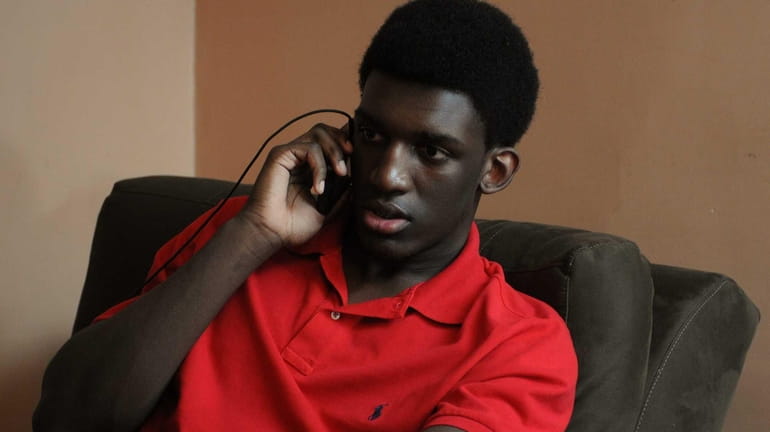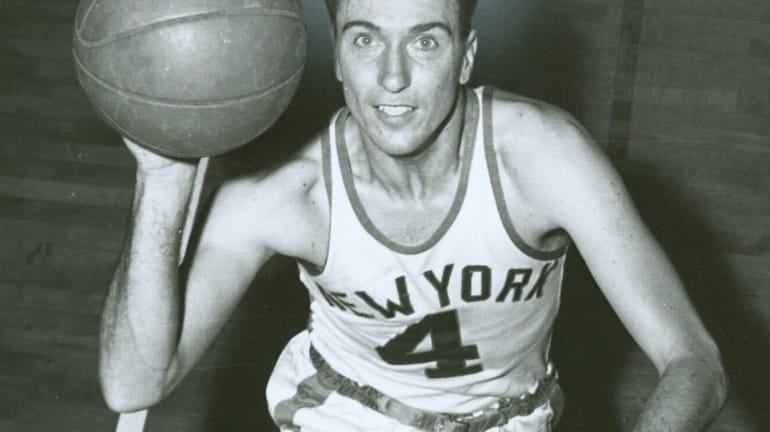Rule change gives recruiters high-tech tools

Kyle Williams, a 6'9" sophomore basketball standout at St. John the Baptist, speaks with Manhattan College head coach Steve Masiello moments after midnight at Williams's home. A change in NCAA rules which allows college coaches to contact potential recruits nearing the completion of their sophomore years went into effect at midnight. (June 15, 2012) Credit: James Escher
As Game 2 of the NBA Finals ended Thursday night, Kyle Williams' focus shifted to what was going to happen 12 minutes later. The 6-9 sophomore center from St. John the Baptist was discussing Kevin Durant's missed shot in the waning seconds of the game in the living room of his family's Freeport home.
"That was a foul," Williams said to AAU teammate Mike Alston of Amityville and Andre Edwards, Williams' SJB and AAU coach, before they waited for the clock to strike midnight like it was New Year's Eve in Times Square.
A new era was about to begin for Williams and thousands of other boys high school basketball players across the country as for the first time, Division I college coaches could start contacting prospective recruits from the classes of 2013 and 2014 via phone, text and social media without limitations.
Williams, who averaged 13.1 points, 10.8 rebounds and four blocks while helping lead the Cougars during an improbable run to the CHSAA state finals last season, is one of Long Island's top incoming juniors being targeted by college coaches. It takes just 18 seconds for the first contact, a call to Williams from Manhattan (the Jaspers verbally offered Williams a scholarship on Wednesday) and a new era of basketball recruiting was born.
The new deal
In October, the NCAA changed its men's basketball recruiting rules to allow college coaches to begin contact with players directly and without limitations via phone calls, text and social media. Previously coaches could only call a player once a month from June 15 after their sophomore year through July 31 of their junior year and twice a week after August 1 of their junior year and all text messages were prohibited but players could call college coaches on a limitless basis.
After exhausting their permissible number of calls, coaches would have to relay messages to recruits through middlemen ranging from high school and AAU coaches to hangers-on.
These restrictions made building relationships with recruits harder for coaches, said Steve Lavin of St. John's and Hofstra's Mo Cassara. It also presented practical difficulties where if a recruit called and left a message, the coach could not call back if they had already used their allotted amount for the month.
"I can remember once we were down to the end with a recruit and I had my phone on in the movies," Cassara said from his office where he had three computer screens and two phones at his disposal on Friday. "I had to run out through the hallways of the movie theater and try to get to a quiet area to take the call because I was waiting for this kid to call me back."
Coincidentally, the movie Cassara had to run out of to take the call was "The Social Network." Cassara would not say how many high school athletes he planned to contact, but he tweeted and sent "an incredible amount" of texts.
Lavin, renowned for his recruiting ability after signing top classes while at UCLA and with the Red Storm, supports the new rule and thinks it will be good for coaches and kids. "Naturally having more access is something coaches have pushed for in terms of being able to communicate with the prospects and their families at an earlier stage and more frequently is another step in the right direction," he said Thursday afternoon, "but I think it would be a mistake to assume that more access automatically will create better results in terms of recruiting."
Texts pour in
After the initial call from Manhattan, Williams received texts in rapid succession from coaches at Boston University, Rutgers, Pittsburgh and West Virginia while Yale and Drexel texted his father, who was overseas on business. Kyle received calls from Washington, Pittsburgh, Iowa and Harvard, a text from Siena and coaches from Stanford and Tulane added him on Facebook on Friday.
"I've come a long way," Williams says about his on-court development over the past few years. He wants to major in engineering and is most looking forward to visiting various campuses.
Kyle's mother, Rachael, watches as her 15-year-old son receives messages from across the country.
"It's very exciting," she said. "I'm very happy this is happening and very proud of him."
Rachael Williams said she and her husband, Winston, hope Kyle will choose a college in driving distance and emphasized the importance of a good education and engineering school.
Kyle called Georgetown his dream school because "it seems like every big man that goes there goes to the pros."
Williams expects to grow another one or two inches and will continue to work and develop his jump shot and post moves over the summer, particularly during an upcoming live evaluation period in July. Kyle has 17 months until he can sign a National Letter of Intent should he choose to do so during the early period.
Day one of his recruiting process went like clockwork.

